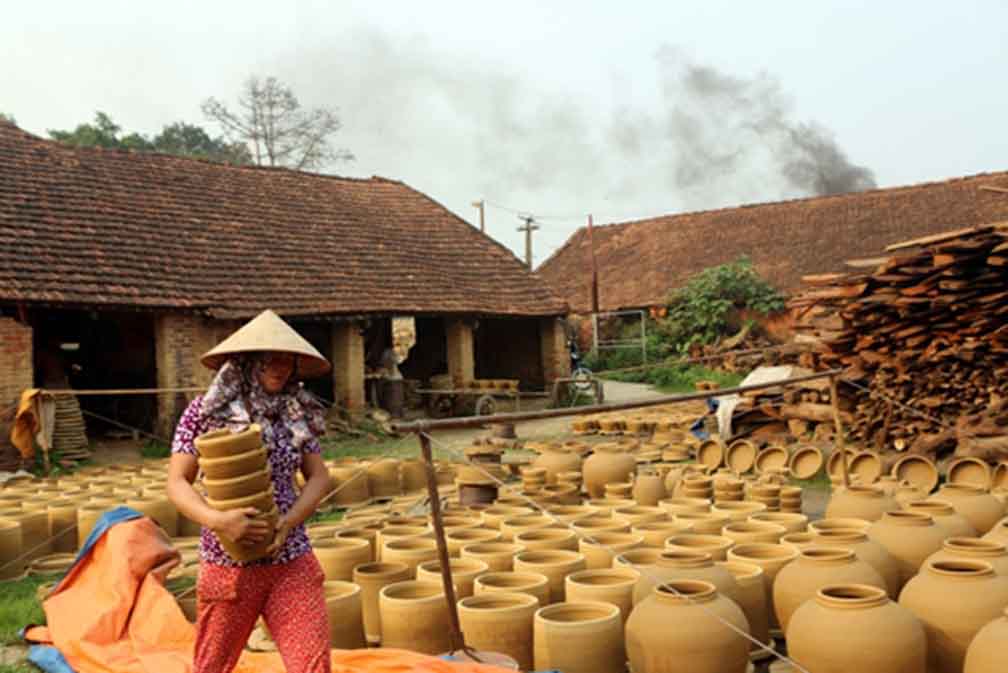Main Products: Ceramic
Ethnic Minority: kinh
From Noi Bai Airport (Hanoi): 50 km
From Tan Son Nhat Airport (HCMC): 1094 km
The village of Que (formerly Danh Xa) in Ha Nam province is one of the oldest ceramic villages in Vietnam. It is located on the lower part of Day River, Kim Bang District, 60 km South of Hanoi.
Visitors to Que usually first comment about the peaceful and warm atmosphere most ancient villages have in common. Away from the noise, pollution and hectic life style of busy urban centres, traditional villages seem to exist beyond time, in a dimension untouched by the ways of a new age. They seem to breathe peacefully and follow a steady pace, unaltered by the digital fury or the imperatives of development. One can rest. Pottery expresses this harmonious pace. It communicates this experiences of stability that characterizes ancient civilizations, images of the persistence of man through the tribulations of time. Its gentle curves and counter curves are signs of cultures that understand the complementarity of opposites, as well as the cyclic return of the seasons and the right nature has over man’s destiny.
Then, after they have been welcomed, visitors can discover the concentrated chambered kilns that have beend used by several generations of potters to produce ceramic articles.
Throughout the ages, pottery has provided for peoples’ daily needs, performed roles in social functions and acted as a media for artistic expression. Que’s ceramics are classified into three main categories: orange terracotta, vermilion terracotta and brown earthenware. They are shaped on the wheel, without glaze, and simply decorated through incising and relief technique, creating the natural and attractive beauty of the pieces. Potters spend a lot of time and manpower at all levels of production: From exploration and treatment of the raw clay, to the stages of shaping and decoration, they put much more than the hand to their work. But it is firing that requires the most time and attention: It takes 12 to 15 days to fire Que’s ceramics. A specific method of progressive and gradual temperature adjustment during the firing and cooling stages guarantees the even and thorough firing of the piece. It also allows the strict control of defective products in order to minimize production costs. Benefiting from abundant reserves of clay, highly skilled potters have made Que’s ceramics increasingly popular on the Vietnamese market together with other famous items from Bat Trang, Binh Duong and Dong Nai. Ceramics are also exported to many countries such as Taiwan, Denmark, Japan, America, Hungary, etc.
Que village produces a vast range of products, among which household items (pots, round and plump jars, urns, etc) and artistic pieces (flower pots, tea-sets, bowls and plates, ash-tray, statues, etc) are the most popular. The high quality yellow clay that potters use naturally melts when it is fired at a specific temperature, allowing craftsmen to express their creativity. According to foreign customers, tea sets from Que keep water warm for a longer period than normal teapots. They also have the particularity to remove chemical residues left on tea leaves, making tea taste better.
The area of Que pottery includes Quyet Thanh ceramic co-operative and some 20 households specializing in producing and trading of terracota articles. They provide a stable income of VND5 million/ year to more than 500 potters and produce more than 200 cubic meters of varied articles every month, for a total revenue of 10 billion a year.



